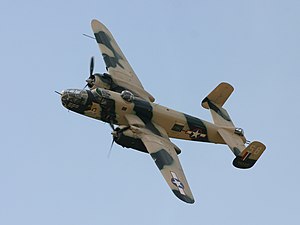B-25
| B-25 Mitchell | |
|---|---|
 |
|
| A B-25 Mitchell in 2007 | |
| Role | Medium bomber |
| National origin | United States |
| Manufacturer | North American Aviation |
| First flight | 19 August 1940 |
| Introduction | 1941 |
| Retired | 1979 (Indonesia) |
| Primary users |
United States Army Air Forces Royal Air Force Soviet Air Force United States Marine Corps |
| Number built | 9,816 |
| Developed from | North American XB-21 |
| Developed into | North American XB-28 Dragon |
The North American B-25 Mitchell is an American twin-engine, medium bomber manufactured by North American Aviation (NAA). It was named in honor of Major General William "Billy" Mitchell, a pioneer of U.S. military aviation. Used by many Allied air forces, the B-25 served in every theater of World War II and after the war ended many remained in service, operating across four decades. Produced in numerous variants, nearly 10,000 Mitchells rolled from NAA factories. These included a few limited models, such as the United States Marine Corps' PBJ-1 patrol bomber and the United States Army Air Forces' F-10 reconnaissance aircraft and AT-24 trainers.
The Air Corps issued a circular (Number 38-385) in March 1938 describing the performance they required from the next bombers — a payload of 1,200 lb (540 kg) with a range of 1,200 mi (1,900 km) at more than 200 mph (320 km/h). Those performance specifications led NAA to submit their NA-40 design. The NA-40 had benefited from the North American XB-21 (NA-39) of 1936, which was the company's partly successful design for an earlier medium bomber that had been initially accepted and ordered, but then cancelled. However, the company's experience from the XB-21 contributed to the design and development of the NA-40. The single NA-40 built flew first at the end of January 1939. It went through several modifications to correct problems. These improvements included fitting 1,600 hp (1,193 kW) Wright R-2600 "Twin Cyclone" radial engines, in March 1939, which solved the lack of power.
In March 1939, North American delivered the substantially redesigned and improved NA-40 (as NA-40B) to the United States Army Air Corps for evaluation. It was in competition with other manufacturers' designs (Douglas 7B, Stearman X-100, and the Martin Model 167F) but failed to win orders. The aircraft was originally intended to be an attack bomber for export to the United Kingdom and France, both of which had a pressing requirement for such aircraft in the early stages of World War II. However, the French had already opted for a revised Douglas 7B (as the DB-7). Unfortunately, the NA-40B was destroyed in a crash on 11 April 1939 while undergoing testing. Although the crash was not considered due to a fault with the aircraft design, the Army ordered the DB-7 as the A-20.
...
Wikipedia
